
Environment and Climate Change Canada
March 2021
Prepared for:
Environment and Climate Change Canada
Supplier Name: Quorus Consulting Group Inc.
Contract Award Date: September 4, 2020
Delivery Date: March 2021
Contract Amount (incl. HST): $39,942.68
Contract #: K2A52-210246/001/CY
POR Number: 030-20
For more information, please contact:
ec.rop-por.ec@canada.ca
Ce rapport est aussi disponible en français.
Species at Risk, Nature Conservation and Nature-Based Solutions Survey for the Canadian Wildlife Service
Final Report
Prepared for Environment and Climate Change Canada
Supplier name: Quorus Consulting Group Inc.
March 2021
This public opinion research report presents the results of a national survey conducted with 2,006 Canadians using an online panel of Canadian households. The survey was conducted from December 3 to December 10, 2020.
Cette publication est aussi disponible en français sous le titre :
Enquête sur les espèces menacées d’extinction, la conservation de la nature et les solutions naturelles pour le Service canadien de la faune
This publication may be reproduced for non-commercial purposes only. Prior written permission must be obtained from Environment and Climate Change Canada. For more information on this report, please contact ECCC at: ec.rop-por.ec@canada.ca or at:
Department of the Environment
200, boul. Sacre-Coeur
Gatineau, Quebec
K1A 0H3
Catalogue Number:
CW66-752/1-2021E-PDF
International Standard Book Number (ISBN):
ISBN 978-0-660-38457-3
Related publications (registration number: POR 030-20):
Catalogue Number CW66-752/1-2021F-PDF (Final Report, French)
ISBN 978-0-660-38458-0
© Her Majesty the Queen in Right of Canada, as represented by the Minister of Environment and Climate Change Canada, 2021
Political Neutrality Certification
I hereby certify as Senior Officer of Quorus Consulting Group Inc. that the deliverables fully comply with the Government of Canada political neutrality requirements outlined in the Policy on Communications and Federal Identity and the Directive on the Management of Communications - Appendix C.
Specifically, the deliverables do not include information on electoral voting intentions, political party preferences, standings with the electorate or ratings of the performance of a political party or its leaders.
Signed:

Rick Nadeau, President
Quorus Consulting Group Inc.
One of the Government of Canada’s top priorities is nature conservation, which includes protected areas, species at risk and nature-based solutions to climate change. With the $1.3 billion historic investment in Nature Legacy in Budget 2018, there is an increased need to communicate effectively on these topics and to understand the public’s attitudes, opinions and beliefs, both to create a benchmark but also to gather insights for policy and communication decisions.
Ultimately, this research assesses Canadians’ views on these priorities. In other words, the research validates whether Canadians are making the link between nature-based solutions and climate change mitigation, in order to develop a communications approach to inform Canadians about this. The results will help to better develop outreach and communication strategies for species at risk. Finally, the results will also help to better understand how Canadians value and prioritize nature conservation.
This research aimed to identify the proportion of Canadians who are not in support of establishing protected areas and recovering species at risk, compared to those who are, as well as explored why they are not in support of these initiatives.
Report findings are based on a non-probability sample, as respondents had volunteered to participate in online surveys using an online panel. The data have been weighted to reflect the demographic composition of the Canadian general population. As the sample is based on those who initially self-selected for participation in the online panel, no estimates of sampling error can be calculated. All research work was conducted in accordance with the professional standards established by the Government of Canada Public Opinion Research Standards.
Data collection occurred between December 3 and December 10, 2020. A total of 2,006 surveys were completed using a stratified random sampling approach within the online panel of Canadian households. For this study, quotas by province were established to generate sufficient data regionally for robust analysis. Data was monitored to aim for a 50/50 gender split in each province, and that no specific age cohort was under-represented. The equivalent margin of error for a probability study would be +/-2.2%.
Nearly 3 in 5 respondents (57%) specified that nature is very important to their personal well-being another 39% considered it somewhat important.
Respondents were presented with a list of nature-based concepts and asked to describe their level of familiarity with each. Respondents were most familiar with climate change (89% were very or somewhat familiar), followed by nature conservation (83%), greenhouse gas emissions (81%) and species at risk of extinction (78%). Familiarity decreases further for concepts like nature restoration (64%), biodiversity (63%), climate change adaptation (60%) and climate change mitigation (58%). Familiarity was at its lowest when it came to international environment agreements (50%) and nature-based climate solutions (43%).
Across a list of Government of Canada environmental initiatives, respondents were most aware of the banning of certain types of single use plastics by 2021 (76% were either very or somewhat aware). This was closely followed by initiatives to reduce greenhouse gas emissions by 2030 (67%) and ensuring carbon tax or cap and trade systems exist across Canada (61%). Awareness falls below 60% for initiatives such as the initiative to achieve net-zero emissions by 2050 (57%), initiatives to restore important ecosystems (48%), to ensure pollution pricing (48%) and to introduce the clean fuel standard (44%). Among the initiatives presented, awareness was the lowest (37%) for the initiative to protect 25% of Canada's lands and 25% of its oceans by 2025.
Respondents were presented with the definition of “Nature-Based Solutions” and were asked how realistic several statements appeared to be based on that definition. Respondents felt that the most realistic solution was trees capturing carbon from the air and storing it to reduce the amount of carbon in the air (79%), followed by farmers using cover crops to prevent erosion to help to build carbon in the soil (65%), and having large enough amounts of carbon captured and stored by trees and plants to help reduce Canada’s greenhouse gas pollution (55%).
Based on previous knowledge, 81% of respondents agree (very and somewhat agree) that Nature-Based Solutions focus on protecting, restoring, and sustainably managing nature to help solve challenges to society, and 75% agree Nature-Based Solutions help reduce impacts from extreme weather events, such as flooding.
Respondents were asked to describe in their own words the concept of nature conservation. Respondents provided a diverse list of responses, mainly mentioning the preservation of the environment (14%) and the preservation of nature or ecosystems specifically (12%). These terms were followed by the protection of a green space (8%), the management of forestry specifically (8%), the importance of reducing carbon footprints (7%), the reduction carbon emissions (7%) and the protection of species from extinction (7%). Many respondents (37%) did not know what words they would use to explain the concept of nature conservation.
When presented with specific nature conservation definitions, 88% agree conservation refers to activities that help nature to recover from damage caused by human activity or natural disturbances, while 85% agreed conservation means allowing human activity that is low-impact, and managing it so that nature is not degraded or destroyed, and 74% agreed it refers to protecting nature exactly as it is, not allowing people to change it.
Respondents were asked to describe their level of familiarity with some benefits to nature of wetland restoration, and the revitalizing of their natural functions. Three quarters of respondents (74%) were very or somewhat familiar with the benefit that explains that restored wetlands can create food and habitat for birds, pollinators, and other animals. This was followed by the benefits that restored wetlands can reduce the risk and extent of flooding by soaking up excess water (63%) and that they can provide recreational and educational opportunities for people (61%). Respondents were least familiar (55%) with the benefit that explains that restored wetlands can capture and store carbon from the atmosphere.
Based on their previous knowledge, over 4 in 5 respondents (83%) assert that the action of planting and keeping a lot of mature trees in cities to clean the air is a cost-effective action (very or somewhat cost-effective), while 72% say that investing in the protection or carbon-rich ecosystems, as well as restoring and enhancing wetlands are cost-effective actions.
Most respondents (87%) strongly supported or supported the federal government’s commitment to protect and conserve 25% of land and freshwater by 2025, after reading the following text:
Since 2017, Canada has recognized additional land and freshwater protected and conserved areas equivalent in size to three times the size of Nova Scotia, and now protects 12.1% of our land and inland waters. In the September 2020 Speech from the Throne, the federal government re-iterated its commitment to protect and conserve 25% by 2025. This commitment would include the creation of new parks, wildlife conservation areas and other types of protected areas.
Respondents were informed that provinces and territories control over 80% of Canada’s land and inland waters. They were then asked to state their level of agreement with the federal government providing funding to provinces and territories in order to assist the creation of new parks and protected areas to advance the 25% target. Over 4 in 5 respondents (85%) strongly or somewhat agreed that the federal government should provide this funding to provinces and territories.
Following, respondents were asked to state their level of agreement with three approaches to ensuring that Canada can continue to have the necessary funding to manage and grow protected and conserved areas. Over 3 in 4 respondents (76%) strongly or somewhat agreed with the approach of offering greater federal tax benefits for Canadians who donate land for nature conservation purposes. This was followed by the federal government allowing taxpayer money to be invested in new financing mechanisms with specific environmental benefits (69%) and the prospect of raising money to expand nature conservation through a border tax of $25 or less for foreign tourists (65%).
In terms of the roles the federal government could play to assist with environmental protection and biodiversity conservation, over 4 in 5 respondents (84%) strongly or somewhat agreed that the federal government should assist and provide funding to municipal governments to support biodiversity conservation at the local level. A similar proportion (81%) felt that the federal government should require improved land management practices. The lowest level of agreement (76%) was that the federal government should enable greater involvement of Indigenous peoples in protecting nature.
Survey participants were explained that some governments require that companies undertaking projects like mines and pipelines compensate for environmental damage caused by their project. They were also explained that compensation can be done by undertaking conservation projects, paying a company or a non-profit environmental organization to undertake a specific conservation project, or paying into a fund that supports conservation projects. Respondents were asked to provide their level of agreement with the idea of having the federal government develop an initiative requiring companies to compensate the damage to the environment caused by their projects as a condition of their federal project approval, to which 84% of respondents strongly or somewhat agreed. These respondents were then asked to select a single compensation approach from a list of alternatives. Support was highest for companies to pay into a fund that supports conservation projects (36%) and requiring companies to pay non-profit environmental organizations to carry out conservation projects (35%). Support reached 16% for the option that would require companies to pay other companies to carry out conservation projects and 14% supported the option that would require companies undertake conservation projects themselves.
Respondents were asked to indicate how much of a priority a list of environmental issues should be for the Government of Canada, using a scale of 1 to 10, with a rating of 10 being the highest priority. Support was highest (provided a rating from 7 to 10) for protecting natural habitats for wildlife (91%) and reducing water pollution (90%). These were closely followed by protecting Canada’s National Parks and National Wildlife Areas (89%), reducing air pollution (86%), protecting endangered species (86%), and reducing garbage and waste (86%). Many felt that protecting endangered plant species (82%), fighting climate change (82%), and reducing greenhouse gas emissions (81%) were high priorities. Less respondents prioritized creating clean jobs (79%), creating more urban parks and green spaces (78%), creating new National Parks and National Wildlife Areas (75%) and creating green jobs (74%).
Respondents were made aware that there are currently 622 terrestrial and aquatic species at risk of extinction in Canada. They were then asked to rate the extent to which it is important to them personally that species at risk of extinction across Canada be protected. Most respondents (88%) indicated it is very or somewhat important to them personally that species at risk are protected across Canada.
Over 4 in 5 respondents (83%) strongly or somewhat agreed that the federal government should focus its species-specific conservation efforts and investments on a manageable number of ecologically important and wide-ranging priority species, such as caribou, greater sage-grouse, and wood bison. In addition, respondents were asked to indicate if they preferred that the Government of Canada spread resources across all species at risk of extinction or if it should focus on a select set of species and ecosystems. Respondents could also select a balance of both of these approaches or none of them at all. Over half of respondents (57%) felt that the federal government should adopt a balanced approach. Roughly one quarter of participants (24%) would prefer the federal government focuses on spreading resources across all species at risk of extinction, while 13% would prefer efforts be focused on a select set of species and ecosystems.
Additionally, 35% of respondents ranked selecting species most at risk of extinction as the number one criterium to use to prioritize resources in Canada to protect some species instead of others. The remaining criteria received similar rankings such that, overall, they are all equally important. This includes selecting species found only in Canada, (16%), species found all across Canada (instead of species that only live in one area or province/territory – 14%), species iconic or emblematic to Canada (i.e., polar bear, caribou – 13%), species with the best chance of recovery (12%), and species that contribute to global biodiversity (11%).
Respondents were also asked the extent to which they would agree with an approach that would have the government abandon recovery efforts for some species, in favour of focusing on other species that have a higher chance of survival. Over half of respondents (59%) strongly or somewhat agreed with the proposed approach.
Respondents were asked to rank a list of key stakeholders based on who they believed should take primary responsibility for the recovery and protection of species at risk of extinction in Canada. Nearly two thirds of respondents (62%) ranked the federal government as having the primary responsibility for the recovery and protection of species at risk of extinction in Canada. The next most important stakeholder would be provincial and territorial governments, who were considered the primary choice by 18% of respondents.
Survey participants were also asked to rank a list of key stakeholders based on who they believed should take primary responsibility for the recovery and protection of a species if it is within one province or territory. Over a third of respondents (38%) ranked as number one the provincial or territorial government to have the primary responsibility for the recovery and protection of species primarily found within one province or territory, and 39% as the number two responsible. In addition, the federal government was considered the primary choice by 41% of respondents, and the secondary choice by 21% of respondents. In terms of average ranking, municipal governments ranked third and Indigenous communities ranked fourth. Individuals/landowners and private business were ranked lowest.
Over three quarters of respondents (78%) strongly or somewhat agreed that if an animal species at risk of extinction was found on land slated for commercial development bringing new employment opportunities, protection of these animal species should take priority over developing that land. Nearly as many (72%) felt the same way about a plant species at risk.
Over half (53%) of respondents who agreed with the protection of either animal or plant species on land slated for commercial development felt that the provincial government should be responsible for protecting the species. Slightly fewer felt the federal (48%) and the municipal governments (46%) should be responsible. To a lesser extent, respondents believed the landowner should be responsible (37%).
In terms of responsibility for ensuring the protection of endangered plant populations and their habitats if these are found on privately managed land, results suggest that the federal government (34%) is seen as the most popular stakeholder to take primary responsibility, followed by property owners (30%), and the provincial government (20%). Considering the results for the number two responsible for protecting endangered plant populations, provincial governments take the lead at 42% preference.
Respondents were asked to state their level of agreement with statements regarding increased responsibility with and regulatory action among stakeholders to protect species at risk in Canada. Over 4 in 5 respondents (84%) either strongly agree or somewhat agree that private natural resource and urban development companies should do more to protect species at risk of extinction. Similarly, 84% agree that the federal government should take stronger regulatory action and enforcement action, since it currently relies heavily on voluntary stewardship to protect species at risk of extinction.
Supplier Name: Quorus Consulting Group Inc.
Contract #: K2A52-210246/001/CY
Contract Award Date: September 4, 2020
Contract Amount (incl. HST): $39,942.68
For more information, please contact Environment and Climate Change Canada at: ec.rop-por.ec@canada.ca
One of the Government of Canada’s top priorities is nature conservation, which includes protected areas, species at risk and nature-based solutions to climate change. With the $1.3 billion historic investment in Nature Legacy in Budget 2018, there is an increased need to communicate effectively on these topics and to understand the public’s attitudes, opinions and beliefs, both to create a benchmark but also to gather insights for policy and communication decisions.
Ultimately, this research assesses Canadians’ views on these priorities. In other words, the research validates whether Canadians are making the link between nature-based solutions and climate change mitigation, in order to develop a communications approach to inform Canadians about this. The results will help to better develop outreach and communication strategies for species at risk. Finally, the results will also help to better understand how Canadians value and prioritize nature conservation.
This research aimed to identify the proportion of Canadians who are not in support of establishing protected areas and recovering species at risk, compared to those who are, as well as explored why they are not in support of these initiatives. As stated, the objectives of the quantitative research were focused on the following:
Regarding each of these broad themes, the objectives of the research were:
Nearly 3 in 5 respondents (57%) specified that nature is very important to their personal well-being. This increases to more than 9 in 10 (96%) when including those who felt that nature is at least somewhat important to their personal well-being.
Figure A – Importance of Nature to Personal Well-Being
Q1. To start, how important is nature to your personal well-being? Base: All respondents, n=2006

Key Segments
Women were more likely to state that nature was very important to their well-being compared to men (61% vs 52%).
The importance of nature to personal well-being was more likely to be considered very important among those aged 35 years or older when compared to respondents 18 to 34 years old (59% vs 51%).
At a regional level, respondents living in British Columbia (62%) were more likely to state that nature was very important to their well-being when compared to those living in Quebec (54%) and Manitoba/Saskatchewan (51%).
The importance of nature to personal well-being was more likely to be considered very important among those with an education level above high school when compared to those with a high school education (58% vs 52%).
Indigenous respondents were more likely to express that their relationship between nature and their personal well-being was very important compared to non-indigenous respondents (69% vs 56%).
Respondents were presented with a list of nature-based concepts and asked to describe their level of familiarity with each. Overall, each of the concepts presented were at least somewhat familiar to more than 2 in 5 respondents (42%).
Figure B – Familiarity with Nature-Based Concepts and Terms
Q2. How familiar are you with the following concepts and terms? Base: All respondents, n=2006
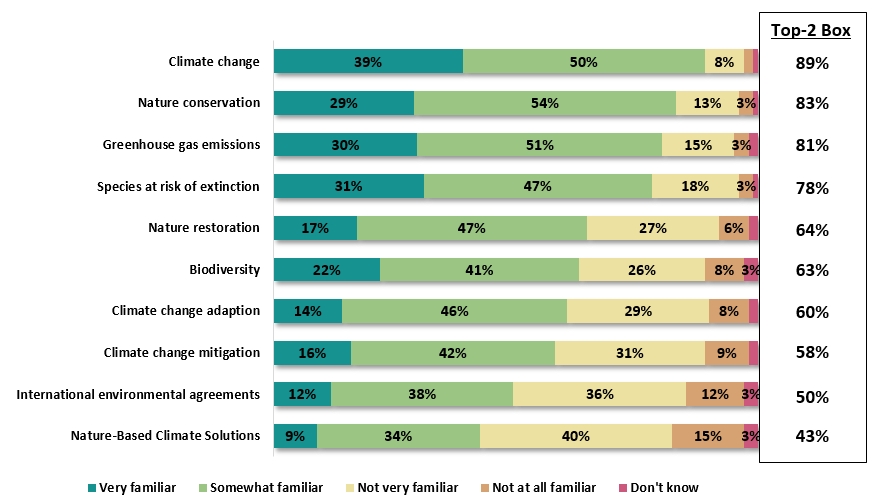
Of the 10 concepts presented, respondents were most familiar with climate change as nearly 9 in 10 (89%) reported being at least somewhat familiar with the concept. Nearly 4 in 10 (39%) described their level of familiarity with climate change as very familiar, the highest among all concepts.
Familiarity was also relatively high for nature conservation (83%), greenhouse gas emissions (81%) and species at risk of extinction (78%).
Roughly six in ten participants were at least somewhat familiar with the concepts of nature restoration (64%), biodiversity (63%), climate change adaptation (60%) and climate change mitigation (58%).
Familiarity was at its lowest when it came to international environment agreements (50%) and nature-based climate solutions (43%).
Key Segments
Respondents who specified the importance of nature to their personal well-being as very important were more likely to report being very or somewhat familiar with all concepts other than greenhouse gas emissions, when compared to those viewing nature’s importance to their well-being as somewhat or less important.
Respondents with a household income of more than $100,000 were more likely to report being very or somewhat familiar with the concepts of the following terms and concepts when compared to those with a household income lower than $40,000:
University educated respondents were more likely to report being very or somewhat familiar with all of the terms and concepts presented when compared to those with a high school education.
College/CEGEP/Trade school educated respondents were also more likely to report being very or somewhat familiar with the following terms and concepts when compared to those with a high school education:
Respondents who completed the survey in English were more likely to report being very or somewhat familiar with the following terms and concepts when compared to respondents who completed it in French:
Respondents who completed the survey in French were more likely to report being very or somewhat familiar with the following terms and concepts when compared to respondents who completed it in English:
Men were more likely to report being very or somewhat familiar with the following terms and concepts when compared to women:
Respondents 18 to 34 years old were more likely to report being very or somewhat familiar with the concepts of biodiversity, climate change mitigation and nature-based climate solutions when compared to those 35 years or older.
Respondents aged 55 years or older were more likely to report being very or somewhat familiar with the concept of nature conservation when compared to respondents under the age of 55 (87% vs 81%).
Respondents were asked to state their level of awareness regarding a list of Government of Canada environmental initiatives. Overall, at least 1 in 3 respondents (37%) were at least somewhat aware of each of the initiatives.
Figure C – Awareness of Government of Canada Environmental Initiatives
Q3. Please state your level of awareness regarding the following Government of Canada environmental initiatives? Base: All respondents, n=2006
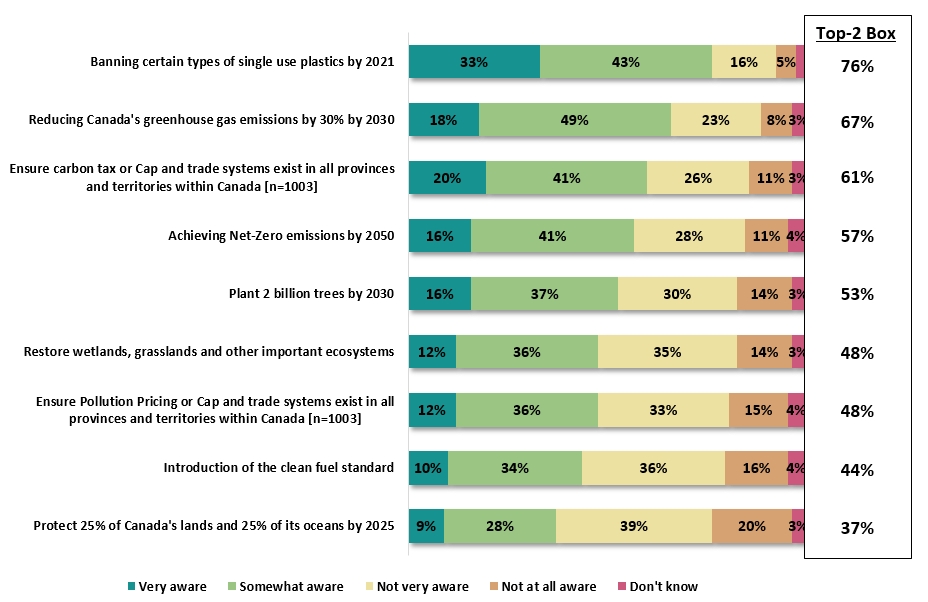
Over 3 in 4 respondents (76%) were at least somewhat aware of the banning of certain types of single use plastics by 2021. Approximately 1 in 3 respondents (33%) described their awareness level as very aware of the banning of single use plastics, the highest among all initiatives.
More than 3 in 5 participants were at least somewhat aware of the initiatives to reduce greenhouse gas emissions by 2030 (67%) and ensuring carbon tax or cap and trade systems exist across Canada (61%). Nearly 3 in 5 participants (57%) were at least somewhat aware of the initiative to achieve net-zero emissions by 2050.
When comparing the usage of the term pollution pricing to carbon tax, respondents presented with “carbon tax” were more aware of this initiative (61%) when compared to those presented with “pollution pricing” (48%).
More than 2 in 5 respondents were aware of the initiatives to restore important ecosystems (48%), ensure pollution pricing (48%) and introduce the clean fuel standard (44%). Over 1 in 3 participants (37%) were at least somewhat aware of the initiative to protect 25% of Canada's lands and 25% of its oceans by 2025.
Key Segments
Respondents who specified the importance of nature to their personal well-being as very important were more likely to report being very or somewhat aware of all but the pollution pricing or carbon tax initiatives when compared to those viewing nature’s importance to their well-being as somewhat important or less.
When compared to women, men were more likely to report being very or somewhat aware of all but the initiative to ban certain types of single use plastics by 2021.
Respondents who completed the survey in English were more likely to report being very or somewhat aware of all the government initiatives other than planting 2 billion trees by 2030 when compared to those who completed it in French.
Respondents with a university education were more likely to report being very or somewhat aware of the following initiatives when compared to those with a lower level of education:
When comparing regions, respondents living in Ontario were more likely to report being very or somewhat aware across most initiatives when compared to respondents living in Quebec:
Respondents were presented with the following definition of “Nature-Based Solutions”:
“Nature-Based Solutions” are defined as actions to protect, sustainably manage and restore natural or modified ecosystems, to address society's challenges such as climate change, with multiple benefits for human well-being and biodiversity.
Based on this definition, respondents were then asked to evaluate how realistic they considered a series of scenarios.
Figure D – Extent to Which Specific Nature-Based Solutions Were Considered Realistic
Q4. In case you had never heard of the term before, “Nature-Based Solutions” are defined as actions to protect, sustainably manage and restore natural or modified ecosystems, to address society's challenges such as climate change, with multiple benefits for human well-being and biodiversity. Based on this definition, how realistic do you think the following statements are? Base: All respondents, n=2006
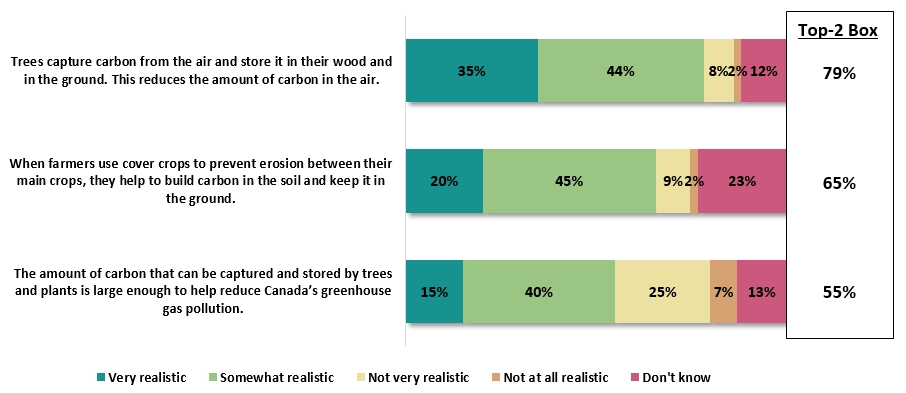
Overall, more than half of respondents (55%) felt that each example or scenario was very or somewhat realistic. It is worth noting as well that nearly one in four did not feel comfortable rating the scenario involving cover crops (23% indicated Don’t know) and 32% did not consider the following scenario realistic: “The amount of carbon that can be captured and stored by trees and plants is large enough to help reduce Canada’s greenhouse gas pollution.”
Nearly 4 in 5 participants (79%) felt that trees capturing carbon from the air and storing it was at least somewhat realistic to reduce the amount of carbon in the air. Over in 1 in 3 (35%) felt that his statement was very realistic as a Nature-Based Solution.
Two-thirds of respondents (65%) felt that farmers using cover crops to prevent erosion was at least somewhat realistic to helping to build carbon in the soil and keep it in the ground.
More than 1 in 2 participants (55%) felt that it was at least somewhat realistic that the amount of carbon that can be captured and stored by trees and plants was large enough to help reduce Canada’s greenhouse gas pollution.
Key Segments
Respondents who specified the importance of nature to their personal well-being as very important were more likely to report that each Nature-Based Solution was very or somewhat realistic when compared to those viewing nature’s importance to their well-being as somewhat or less important.
Men were more likely to report that each Nature-Based Solution was very or somewhat realistic when compared to women.
Across age groups, respondents aged 55 years or older were more likely to consider the following solutions very or somewhat realistic when compared to those 18 to 54 years old:
Respondents living in all regions outside of Quebec were more likely to consider the following solutions very or somewhat realistic compared to those living in Quebec:
Participants were asked to state their level of agreement with Nature-Based Solution statements based on what they may have previously seen or heard.
Figure E – Agreement with “Nature-Based Solutions” Statements
Q5. Based on what you may have seen or heard, to what extent do you agree or disagree with the following statements? Base: All respondents, n=2006
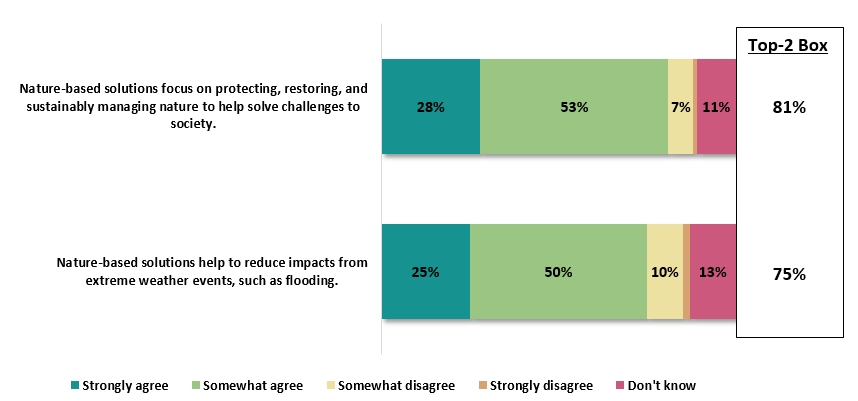
Overall, more than 3 in 4 participants (75%) strongly or somewhat agreed with the “Nature-Based Solutions” statements presented, with roughly half somewhat agreeing.
More than 4 in 5 participants (81%) at least somewhat agreed that Nature-Based Solutions focus on protecting, restoring, and sustainably managing nature to help solve challenges to society and 3 in 4 participants (75%) at least somewhat agreed that Nature-Based Solutions help to reduce impacts from extreme weather events, such as flooding. In the end, very few tended to disagree with each proposed definition while roughly 1 in 10 indicated “Don’t know.”
Key Segments
Respondents with an education level above high school or who consider nature very important to their personal well-being were more likely to strongly or somewhat agree with both Nature-Based Solutions statements when compared to their counterparts.
Respondents were asked to specify in their own words how they would explain the concept of nature conservation to a friend or neighbour.
Figure F – Explaining the Concept of Nature Conservation
Q6. How would you explain the concept of nature conservation to a friend or neighbour? We are not looking for a textbook explanation – we are interested in understanding how you would explain it in your own words. Base: All respondents, n=2006 *Responses above 1%
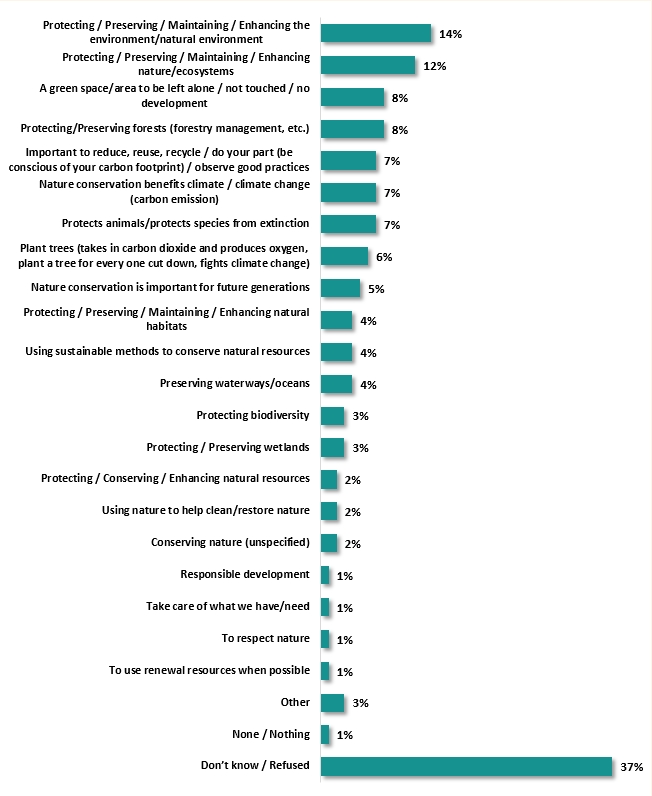
Just over 6 in 10 respondents were able to explain nature conservation in one way or another, while the remaining 38% did not provide an answer or indicated they would not know how to explain the concept to a friend or neighbour. Respondents provided a diverse list of responses with over 1 in 10 respondents mentioning the preservation of the environment (14%) and the preservation of nature or ecosystems specifically (12%).
Nearly 1 in 10 respondents mentioned the protection of a green space (8%), the management of forestry specifically (8%), the importance of reducing carbon footprints (7%), reducing carbon emissions (7%) and protecting species from extinction (7%).
Nearly 2 in 5 respondents (37%) did not know what words they would use to explain the concept of nature conservation to their friend or neighbour.
Key Segments
Respondents who conducted the survey in English were more likely to respond with preservation of the environment when compared to those who completed it in French (15% vs 10%).
Alternatively, the latter were more likely to respond with the reduction of carbon footprints when compared to respondents completing the survey in English (17% vs 5%).
Respondents who specified the importance of nature to their personal well-being as somewhat or less important were more likely to have answered that they did not know how to describe conservation when compared to those viewing nature’s importance to their well-being as very important (46% vs 31%).
Respondents were asked to provide their level of agreement with a series of statements regarding the definition of conservation.
Figure G – Level of Agreement with Conservation-Related Statements
Q7. To what extent do you agree or disagree with the following statements? Conservation means… Base: All respondents, n=2006

Overall, roughly 3 in 4 respondents or more strongly or somewhat agreed with each conservation statement provided.
Agreement was highest (88%) when it comes to conservation meaning activities that help nature to recover from damage caused by human activity or natural disturbances. More than 2 in 5 respondents (44%) strongly agreed with this definition of conservation, the highest level of strong agreement of all definitions proposed.
More than 8 in 10 respondents (85%) at least somewhat agreed that conservation means allowing human activity that is low-impact, and managing it so that nature is not degraded or destroyed.
Nearly 3 in 4 respondents (74%) at least somewhat agreed that conservation means protecting nature exactly as it is, not allowing people to change it.
Key Segments
Respondents who specified the importance of nature to their personal well-being as very important were more likely to strongly or somewhat agree with all of the conservation-related statements when compared to those viewing nature’s importance to their well-being as somewhat or less important.
Respondents at least 55 years old were more likely to strongly or somewhat agree with most conservation descriptions when compared to younger respondents.
Respondents with children under the age of 18 living at home were more likely to strongly or somewhat agree with protecting nature exactly as it is compared to those without children living at home (78% vs 73%).
When comparing regions, respondents living in Quebec (83%) were more likely to strongly or somewhat agree with protecting nature exactly as it is when compared to those living in Ontario (74%), Manitoba/Saskatchewan (69%), Alberta (68%) and British Columbia (67%).
Respondents were asked to describe their level of familiarity with the benefits to nature of wetland restoration, and the revitalizing of their natural functions.
Figure H – Familiarity with the Benefits of Restored Wetlands
Q8. In Canada, many natural wetlands have been drained and had their surrounding natural vegetation cleared away, so that the space could be used for other purposes. How familiar are you with the following benefits to nature when wetlands are restored, and their natural functions are revitalized? Base: All respondents, n=2006

Overall, over half of all respondents (55%) were very or somewhat familiar with the wetland restoration benefits listed.
Over 3 in 4 respondents (74%) were very or somewhat familiar with the benefit that explains that restored wetlands can create food and habitat for birds, pollinators, and other animals. Nearly 2 in 5 respondents (38%) were very familiar with this benefit, the highest level of familiarity across all of the wetland restoration benefits listed in this question.
Nearly 2 in 3 respondents were very or somewhat familiar with the benefit that explains that restored wetlands can reduce the risk and extent of flooding by soaking up excess water (63%) and that they can provide recreational and educational opportunities for people (61%).
Over 1 in 2 respondents (55%) were very or somewhat familiar with the benefit that explains that restored wetlands can capture and store carbon from the atmosphere.
Key Segments
Men were more likely to be very or somewhat familiar with all of the benefits of restored wetlands when compared to women.
Respondents who specified the importance of nature to their personal well-being as very important were more likely to be very or somewhat familiar with all of the benefits of restored wetlands when compared to those viewing nature’s importance to their well-being as somewhat or less important.
Respondents living in Ontario, Manitoba / Saskatchewan and Alberta were more likely to be very or somewhat familiar with all of the benefits of restored wetlands when compared to those living in Quebec.
Respondents with a university education were more likely to be very or somewhat familiar with all of the benefits of restored wetlands when compared to those with a high school education.
Respondents were asked to evaluate the cost-effectiveness of various actions to fight climate change based on what they had previously seen or heard.
Figure I – Perceived Cost-Effectiveness of Specific Actions to Fight Climate Change
Q9. Based on what you may have seen or heard, to what extent could the following actions be cost-effective to fight climate change? Base: All respondents, n=2006

Overall, at least 7 in 10 respondents felt that the three measures presented were very or somewhat cost-effective actions. Similarly, the extent to which any of the proposed measure was not considered cost-effective was relatively low. For two of the measures, an important proportion of respondents selected “Don’t know.”
More than 4 in 5 respondents (83%) felt that the action of planting and keeping a lot of mature trees in cities to clean the air was at least somewhat cost-effective. Over 2 in 5 respondents (44%) felt that this action was very cost-effective, making it the option considered the most effective across all actions presented.
More than 7 in 10 respondents (72%) felt that investing in the protection or carbon-rich ecosystems, as well as restoring and enhancing wetlands were very or somewhat cost-effective actions.
Key Segments
Respondents at least 55 years or older were more likely to consider all of the actions proposed very or somewhat cost-effective compared to those 18 to 54 years old.
Respondents who specified the importance of nature to their personal well-being as very important were more likely to have felt that all of the actions proposed were very or somewhat cost-effective compared to those viewing nature’s importance to their well-being as somewhat or less important.
Men were more likely to have felt that restore and enhance wetlands was very or somewhat cost-effective when compared to women (76% vs 68%).
Francophone respondents were more likely to have felt it was very or somewhat cost-effective to plant and keep mature trees when compared to English respondents (87% vs 82%).
Conversely, respondents completing their survey in English were more likely to have felt it was very or somewhat cost-effective to invest in the protection of carbon-rich ecosystems when compared to Francophone respondents (74% vs 67%).
Respondents were provided the following explanation of the federal government’s commitment to protect and conserve 25% of land and freshwater by 2025:
Since 2017, Canada has recognized additional land and freshwater protected and conserved areas equivalent in size to three times the size of Nova Scotia, and now protects 12.1% of our land and inland waters. In the September 2020 Speech from the Throne, the federal government re-iterated its commitment to protect and conserve 25% by 2025. This commitment would include the creation of new parks, wildlife conservation areas and other types of protected areas.
Figure J – Support for the Commitment to Protect and Conserve 25% by 2025
Q10. Since 2017, Canada has recognized additional land and freshwater protected and conserved areas equivalent in size to three times the size of Nova Scotia, and now protects 12.1% of our land and inland waters. In the September 2020 Speech from the Throne, the federal government re-iterated its commitment to protect and conserve 25% by 2025. This commitment would include the creation of new parks, wildlife conservation areas and other types of protected areas. To what extent do you support this commitment? Base: All respondents, n=2006

Overall, nearly 9 in 10 respondents (87%) strongly supported or supported the federal government’s commitment to protect and conserve 25% of land and freshwater by 2025, with roughly half (49%) strongly supporting this commitment.
Key Segments
Respondents living in Quebec (91%) were more likely to strongly support or support the federal government’s commitment when compared to those living in Alberta (79%), Manitoba / Saskatchewan (84%), and British Columbia (85%).
Respondents who specified the importance of nature to their personal well-being as very important were more likely to strongly support or support the federal government’s commitment when compared to those viewing nature’s importance to their well-being as somewhat or less important (91% vs 82%).
Respondents with a household income between $40,000 to $100,000 were more likely to strongly support or support the federal government’s commitment when compared to those with a household income of under $40,000 (89% vs 84%).
Survey participants were informed that provinces and territories control over 80% of Canada’s land and inland waters. They were then asked to state their level of agreement with the federal government providing funding to provinces and territories in order to assist the creation of new parks and protected areas to advance the 25% target.
Figure K – Agreement with Federal Government Funding
Q11. Provinces and territories control over 80% of Canada's land and inland waters. To what extent do you agree or disagree the federal government should provide funding to provinces and territories to help with the creation of new parks and protected areas in order to advance the 25% target? Base: All respondents, n=2006

Nearly 9 in 10 respondents (85%) strongly or somewhat agreed that the federal government should provide this funding to provinces and territories, with roughly 2 in 5 (42%) strongly agreeing.
Key Segments
Respondents who specified the importance of nature to their personal well-being as very important were more likely to strongly or somewhat agree with the proposed funding when compared to those viewing nature’s importance to their well-being as somewhat or less important (90% vs 80%).
Respondents living in Quebec (89%) were more likely to strongly or somewhat agree with the proposed funding when compared to those living in Alberta (82%) and British Columbia (82%).
Respondents with a university education were more likely to strongly or somewhat agree with the proposed funding when compared to those with a high school education (87% vs 82%).
Respondents with a household income greater than $40,000 were more likely to strongly or somewhat agree with the proposed funding when compared to those with a household income of less than $40,000 (87% vs 82%).
Respondents were asked to state their level of agreement with three different roles that the federal government could play to assist with environmental protection and biodiversity conservation.
Figure L – Level of Agreement with Proposed Federal Government Roles
Q12. To what extent do you agree or disagree with the following statements: Base: All respondents, n=2006
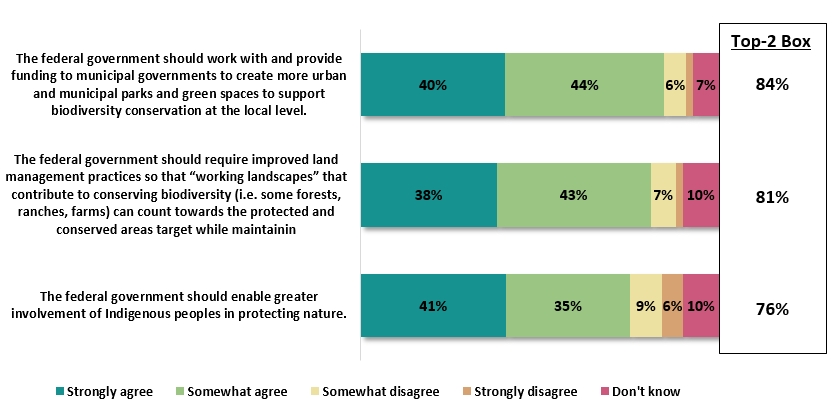
Overall, at least three-quarters of respondents strongly or somewhat agreed with each of the proposed roles. For each proposed role, roughly 4 in 10 strongly agreed. The level of disagreement was highest (15%) when it came to enabling greater involvement of Indigenous peoples in protecting nature.
Nearly 9 in 10 respondents (84%) strongly or somewhat agreed that the federal government should assist and provide funding to municipal governments to support biodiversity conservation at the local level. A similar proportion (81%) strongly or somewhat agreed that the federal government should require improved land management practices.
Finally, over 3 in 4 respondents (76%) strongly or somewhat agreed that the federal government should enable greater involvement of Indigenous peoples in protecting nature.
Key Segments
Respondents who specified the importance of nature to their personal well-being as very important were more likely to strongly or somewhat agree with the proposed federal government roles when compared to those viewing nature’s importance to their well-being as somewhat or less important.
At the regional level, respondents living in Atlantic Canada, Quebec and Ontario were more likely to strongly or somewhat agree with the proposed federal government actions when compared to those living in Alberta.
Non-Indigenous respondents were more likely to strongly or somewhat agree with most of the proposed federal government roles when compared to Indigenous respondents.
Respondents were asked to state their level of agreement with three approaches to ensuring that Canada can continue to have the necessary funding to manage and grow protected and conserved areas.
Figure M – Agreement with Funding Approaches
Q13. To what extent do you agree or disagree with the following approaches as ways to ensure that Canada can continue to have the funding needed to manage and grow protected and conserved areas: Base: All respondents, n=2006
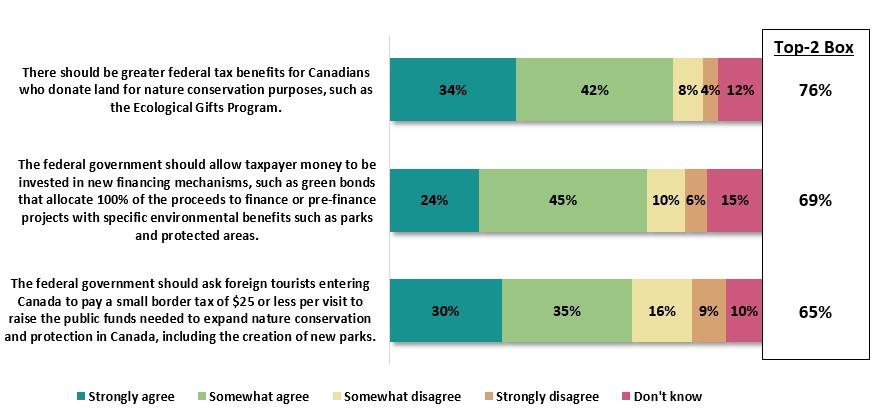
Overall, at least two-thirds of respondents strongly or somewhat agreed with the proposed approaches to ensuring funding for environmental protection and conservation.
Over 3 in 4 respondents (76%) strongly or somewhat agreed with the approach of offering greater federal tax benefits for Canadians who donate land for nature conservation purposes. Roughly one-third strongly agree with this funding solution.
Nearly 7 in 10 respondents strongly or somewhat agreed with the federal government allowing taxpayer money to be invested in new financing mechanisms with specific environmental benefits (69%) and the prospect of raising money to expand nature conservation through a border tax of $25 or less for foreign tourists visiting Canada (65%).
Key Segments
Respondents who specified the importance of nature to their personal well-being as very important were more likely to strongly or somewhat agree with the proposed federal government funding approaches when compared to those viewing nature’s importance to their well-being as somewhat or less important.
Respondents with a university education were more likely to strongly or somewhat agree with each of the federal government funding approaches when compared to those with a high school education.
Men were more likely to strongly or somewhat agree with greater federal tax benefits for Canadians donating land for nature conservation when compared to women (79% vs 74%).
Survey participants were explained that some governments require that companies undertaking projects like mines and pipelines compensate for environmental damage caused by their project. They were also explained that compensation can be done by undertaking conservation projects, paying a company or a non-profit environmental organization to undertake a specific conservation project, or paying into a fund that supports conservation projects. Respondents were asked to provide their level of agreement with the idea of having the federal government develop an initiative requiring companies to compensate the damage to the environment caused by their projects as a condition of their federal project approval.
Figure N – Agreement with Compensation for Environmental Damage
Q14. Some governments require that companies undertaking projects like mines and pipelines compensate for environmental damage caused by their project. Compensation can be done by undertaking conservation projects, paying a company or a non-profit environmental organization to undertake a specific conservation project, or paying into a fund that supports conservation projects. To what extent do you agree or disagree that the federal government should develop a similar initiative that would require companies to compensate for the damage to the environment caused by their projects as a condition of their federal project approval? Base: All respondents, n=2006.

Over 4 in 5 respondents (84%) strongly or somewhat agreed that the federal government should require companies to compensate damage to the environment as a condition of their federal project approval. More than 1 in 2 respondents (51%) strongly agreed with the proposed approach.
Nearly 1 in 10 respondents (9%) did not know if the federal government should require companies to compensate damage to the environment as a condition of their federal project approval.
Key Segments
Respondents who specified the importance of nature to their personal well-being as very important were more likely to strongly or somewhat agree with the proposed approach when compared to those viewing nature’s importance to their well-being as somewhat or less important (88% vs 79%).
Respondents with a household income of $40,000 or more were more likely to strongly or somewhat agree with the proposed approach when compared to those with an income of less than $40,000 (87% vs 78%).
Respondents living in an urban setting were more likely to strongly or somewhat agree with the proposed approach when compared to those living in a rural one (86% vs 81%).
Respondents with an education level above high school were more likely to strongly or somewhat agree with the proposed approach when compared to those with a high school education (86% vs 80%).
When comparing regions, respondents living in Quebec were more likely to strongly agree with the proposed approach when compared to respondents in all other regions (58% vs 49%).
Respondents who answered strongly or somewhat agree to the federal government requiring companies to compensate damage to the environment as a condition of their federal project approval, were then asked to select a single approach from a list of alternatives.
Figure O – Support for Specific Approaches to Environmental Damage Compensation
Q15. Which of the following approaches would you prefer the federal government use to make companies compensate for environmental damage caused by their projects? Base: Respondents who strongly or somewhat agree to federally required damage compensation, n=1680.
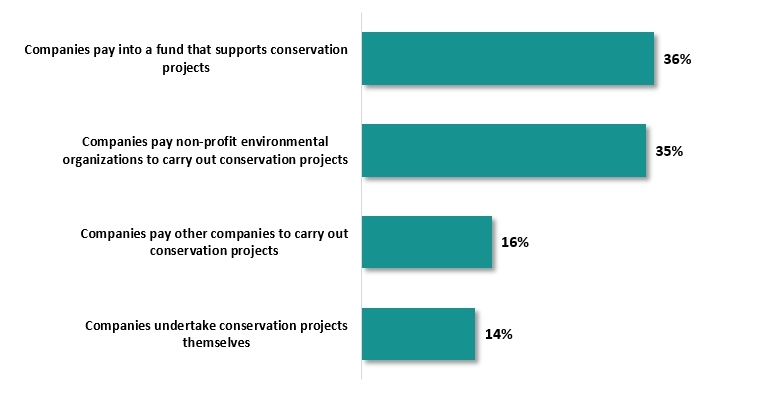
Support was quite similar for the option that would require companies pay into a fund that supports conservation projects (36%) and the one that would require companies pay non-profit environmental organizations to carry out conservation projects (35%).
Support for the other two options was less than half of the support seen for these first two options. Support reached 16% for the option that would require companies pay other companies to carry out conservation projects and 14% supported the option that would require companies undertake conservation projects themselves.
Key Segments
Subsegments that prefer companies pay into a fund that supports conservation projects compared to their counterparts include:
Subsegments that prefer companies pay non-profit environmental organizations to carry out conservation projects include:
Subsegments that prefer companies pay other companies to carry out conservation projects include:
Subsegments that prefer companies undertake conservation projects themselves include:
Respondents were asked to provide other views or examples on how Canada could accelerate progress on creating new protected and conserved areas. Many respondents did not have any additional suggestions (80%) and of the other suggestions provided, few tended to be voiced by more than 1% or 2% of respondents. A detailed list of ideas proposed is provided below.
Figure P – Suggested Alternatives for Progressing Protection and Conservation
Q16. Do you have any other views or examples on how Canada could accelerate progress on creating new protected and conserved areas? Base: All respondents, n=2006.
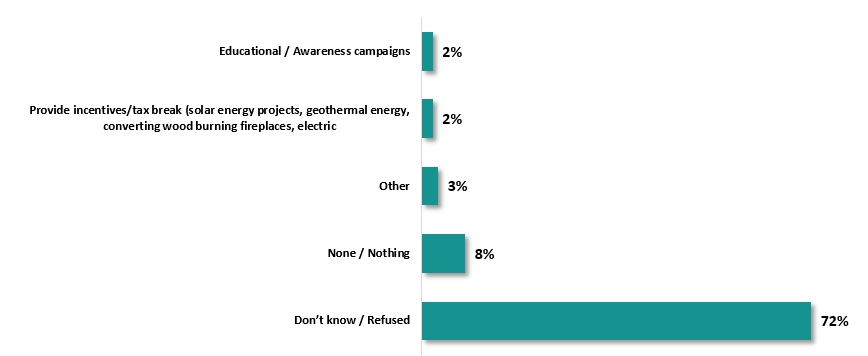
List of Responses Provided by Approximately 1% of Respondents
Respondents were asked to indicate how much of a priority a list of environmental issues should be for the Government of Canada. Respondents were asked to use a scale of 1 to 10, with a rating of 10 being the highest priority. Ratings were then grouped as follows: 7 to 10 in to “High priority”, 4 to 6 into “Somewhat a priority” and 1 to 3 into “Low priority.” Most issues were presented to all respondents; however, some were randomly presented to a sub-group of respondents (i.e., a split sample approach was used) – in these instances, the specific sample size is indicated in the graph.
Figure Q – Perceived Environmental Priorities for the Government of Canada
Q17. Please indicate how much of a priority, if at all, each of the following environmental issues should be for the Government of Canada. Base: All respondents, n=2006.
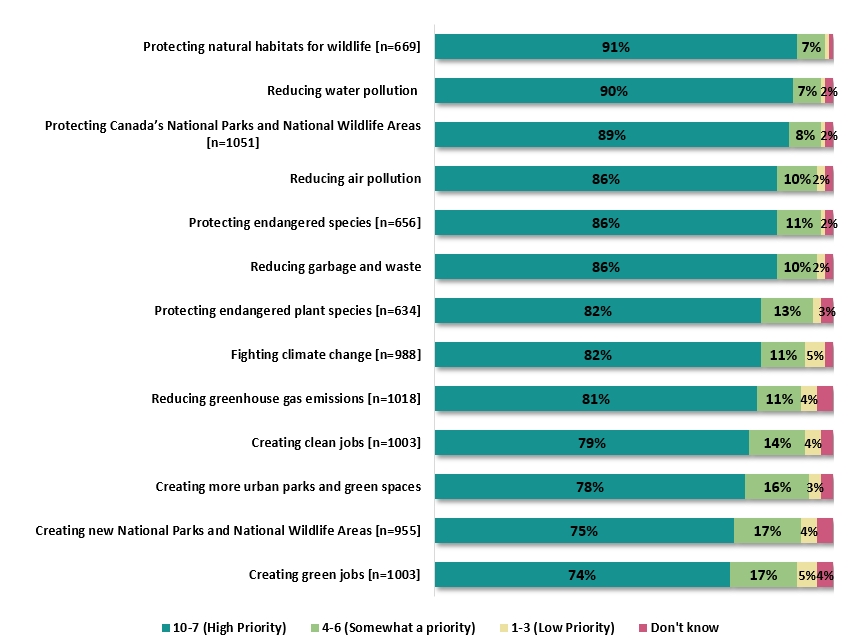
Overall, at least three-quarters of respondents felt that each environmental issue on the list should be a high priority for the Government of Canada.
Support was most widespread for protecting natural habitats for wildlife (91%) and reducing water pollution (90%).
These were closely followed by protecting Canada’s National Parks and National Wildlife Areas (89%), reducing air pollution (86%), protecting endangered species (86%), and reducing garbage and waste (86%).
Roughly four out of five felt that protecting endangered plant species (82%), fighting climate change (82%), and reducing greenhouse gas emissions (81%) were high priorities for the Government of Canada.
Although lower on the list, a handful of other issues were still considered priorities by at least three-quarters of respondents. These included creating clean jobs (79%), creating more urban parks and green spaces (78%), creating new National Parks and National Wildlife Areas (75%) and creating green jobs (74%).
Key Segments
Respondents living in Quebec were more likely to consider all environmental issues other than protecting natural habitats for wildlife a high priority when compared to those living in Alberta.
Women were more likely to consider the following environmental issues a high priority when compared to men:
Non-Indigenous respondents were more likely to consider the following environmental issues as a high priority when compared to Indigenous respondents:
Respondents who specified the importance of nature to their personal well-being as very important were more likely to consider all but protecting endangered plant species as a high priority when compared to those viewing nature’s importance to their well-being as somewhat or less important.
Respondents with a university education were more likely to consider the following environmental issues as a high priority than those with a lower level of education:
Respondents with a level of education above high school were more likely to consider the following environmental issues as a high priority compared to those with a high school education:
Respondents at least 55 years or older were more likely to consider reducing water and air pollution as a high priority when compared to those 54 years or younger.
Respondents were made aware that there are currently 622 terrestrial and aquatic species at risk of extinction in Canada, including caribou, right whale, greater sage grouse, red-legged frog, white sturgeon, salish sucker, western bumble bee and golden paintbrush. They were then asked to rate the extent to which it is important to them personally that species at risk of extinction across Canada be protected.
Figure R – Personal Importance of Protecting Species at Risk of Extinction
Q18. Let's turn our attention to species at risk of extinction in Canada. There are currently 622 terrestrial and aquatic species at risk of extinction in Canada, including caribou, right whale, greater sage grouse, red-legged frog, white sturgeon, salish sucker, western bumble bee and golden paintbrush. How important is it to you personally that species at risk of extinction across Canada are protected? Base: All respondents, n=2006.

Nearly 9 in 10 respondents (88%) indicated it is very or somewhat important to them personally that species at risk are protected across Canada. Within this group, over half believe it is very important to them personally.
Key Segments
Respondents who specified the importance of nature to their personal well-being as very important were more likely to feel that the protection of species at risk was very or somewhat important when compared to those viewing nature’s importance to their well-being as somewhat or less important (92% vs 83%).
Respondents at least 55 years old were more likely to rate protection of species at risk as very or somewhat important when compared to those 54 years of age or younger (91% vs 86%).
Respondents were asked to what extent they agreed that the federal government should focus species-specific conservation efforts and investments on a manageable number of ecologically important and wide-ranging priority species, such as caribou, greater sage-grouse, and wood bison.
Figure S – Level of Agreement with the Federal Government Focusing on Specific Species at Risk
Q19. To what extent do you agree or disagree that the federal government should focus its species-specific conservation efforts and investments on a manageable number of ecologically important and wide-ranging priority species, such as caribou, greater sage-grouse, and wood bison? Base: All respondents, n=2006.

More than 4 in 5 respondents (83%) strongly or somewhat agreed that the federal government should focus its species-specific conservation efforts and investments, with over one-third (35%) strongly agreeing.
Key Segments
Respondents living in Quebec were more likely to strongly or somewhat agree that the federal government should focus its species-specific conservation efforts and investments when compared to respondents in the rest of Canada (88% vs 80%).
Respondents who specified the importance of nature to their personal well-being as very important were more likely to strongly or somewhat agree that the federal government should focus its species-specific conservation efforts and investments compared to those viewing nature’s importance to their well-being as somewhat or less important (86% vs 78%).
In terms of how the Government should focus its efforts, investments and priorities, respondents were asked to indicate if they prefer that the Government spread resources across all species at risk of extinction or if it should focus on a select set of species and ecosystems. Respondents could also select a balance of both of these approaches or none of them at all.
Figure T – Support for Approaches to Focusing Federal Government Priorities and Efforts Towards Species at Risk
Q20. Which of the following statements does your opinion best align with: "Given the limited resources and funding to advance protecting species at risk of extinction in Canada, the federal government should set priorities and focus efforts and investments on..." Base: All respondents, n=2006.
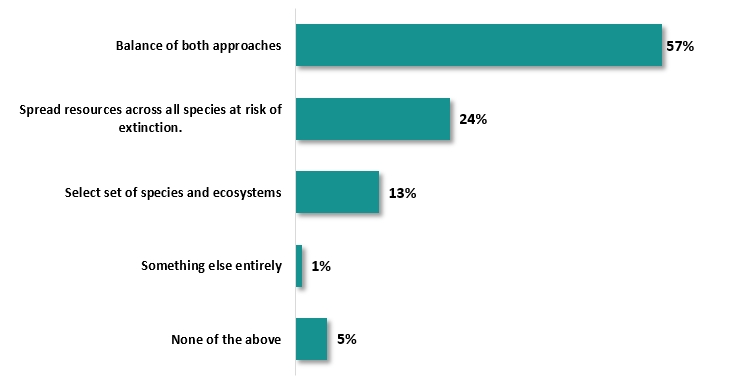
Nearly 3 in 5 respondents (57%) felt that the federal government should adopt a balanced approach involving both a select set of species and ecosystems and spreading resources across all species at risk of extinction.
Among those who did lean towards a specific approach, support was highest for the one that would have the Government of Canada focus on a spreading resources across all species at risk of extinction (24%) while 13% would prefer that federal government efforts be focused on a select set of species and ecosystems.
Key Segments
Subsegments more likely to select a balance of both approaches compared to their counterparts include:
Respondents with a university degree were more likely to opt for a select set of species and ecosystems when compared to those without a university degree (16% vs 9%).
Respondents were presented with the challenge of prioritizing resources in Canada to protect some species instead of others by ranking a list of criteria from top to bottom. Overall, more than 1 in 10 respondents (11%) ranked each species priority as the top selection.
Figure U – Ranking Criteria for Prioritizing Species at Risk
Q21. If you were faced with the challenge of prioritizing resources in Canada to protect some species instead of others, what criteria would you use? We propose a list of criteria below - rank them in terms of how important you believe that criteria would be, in other words those at the top of your list would be prioritized species. Rank the items in order of priority. Base: All respondents, n=2006.
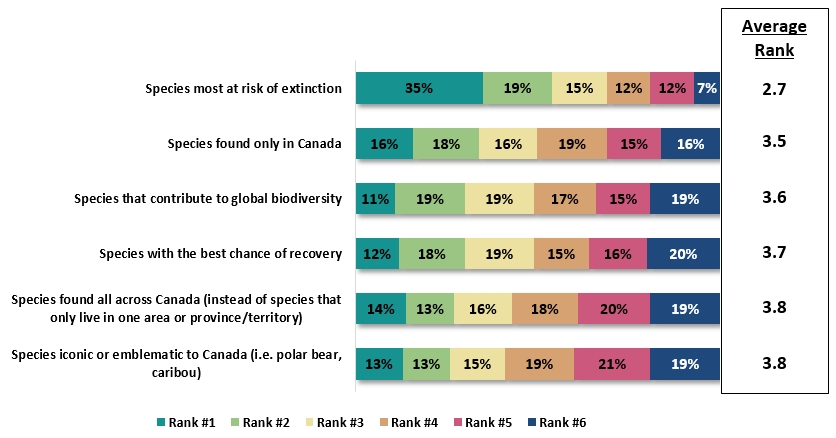
When comparing the top ranking for the species priorities criteria, over 1 in 3 respondents (35%) ranked species most at risk of extinction as their highest priority. The remaining criteria received similar rankings such that, overall, they are all equally important although by focusing on Top-2 Box ranking, we can see that species found only in Canada do stand apart compared to species found all across Canada and species iconic/ emblematic to Canada.
When asked if they could think of any other criteria that could or should be used, no criteria other than what had already been proposed was suggested.
Key Segments
Subsegments more likely to rank Species Most at Risk of Extinction as the highest selection criterium compared to their counterparts include:
Subsegments more likely to rank Species Found Only in Canada as the highest or second highest selection criterium compared to their counterparts include:
Subsegments more likely to rank Species Contributing to Global Biodiversity as the highest selection criterium compared to their counterparts include:
Subsegments more likely to rank Species with the Best Chance of Recovery as the highest selection criterium compared to their counterparts include:
Subsegments more likely to rank Species Found All Across Canada as the highest selection criterium compared to their counterparts include:
No subsegments were more likely than their counterparts to rank Species Iconic to Canada as the highest selection criterium.
Respondents were asked the extent to which they would agree with an approach that would have the government abandon recovery efforts for some species, in favour of focusing on other species that have a higher chance of survival.
Figure V – Support for Focusing on Species with a Higher Survival Chance
Q23. Species conservation includes government making difficult decisions. To what extent do you agree or disagree with an approach that would abandon recovery efforts for some species, in favour of focusing on other species that have a higher chance of survival? Base: All respondents, n=2006.

Nearly 3 in 5 respondents (59%) strongly or somewhat agreed with the proposed approach, with 12% indicating they strongly agree. On the other side of the spectrum, 21% somewhat disagree with the proposed approach, 8% strongly disagree and 12% indicated “Don’t know.”
Key Segments
Segments of the population more likely to strongly or somewhat agree with the proposed approach included:
Respondents were asked to rank a list of key stakeholders based on who they believed should take primary responsibility for the recovery and protection of species at risk of extinction in Canada.
Figure W – Who Should Take Primary Responsibility for Species at Risk Protection – Stakeholder Ranking
Q24. Who should take primary responsibility for the recovery and protection of species at risk of extinction in Canada? Rank the items below in order of priority. Base: All respondents, n=2006.

The majority of respondents (62%) ranked the federal government as having the primary responsibility for the recovery and protection of species at risk of extinction in Canada.
The next most important stakeholder would be provincial and territorial governments, who were considered the primary choice by 18% of respondents, and 54% ranking them second. In terms of average ranking, municipal governments ranked third and Indigenous communities ranked fourth. Individuals/landowners and private business were ranked last and next to last by a majority of respondents (58% and 60% respectively).
Key Segments
Federal Government
Respondents more likely to rank the federal government as the top primary stakeholder compared to their counterparts include:
Provincial or Territorial Government
Respondents more likely to rank the provincial or territorial government as the top primary stakeholder compared to their counterparts include:
Municipal Government
Indigenous Communities
Individuals/Landowners
Private Business
Respondents were asked to rank a list of key stakeholders based on who they believed should take primary responsibility for the recovery and protection of a species if it is within one province or territory.
Figure X – Ranking Primary Responsibility for Species Protection in One Province or Territory
Q25. Whom do you think should take primary responsibility to recover and protect a species, if it is found primarily within one province or territory? Rank the items in order of priority. All respondents, n=2006.
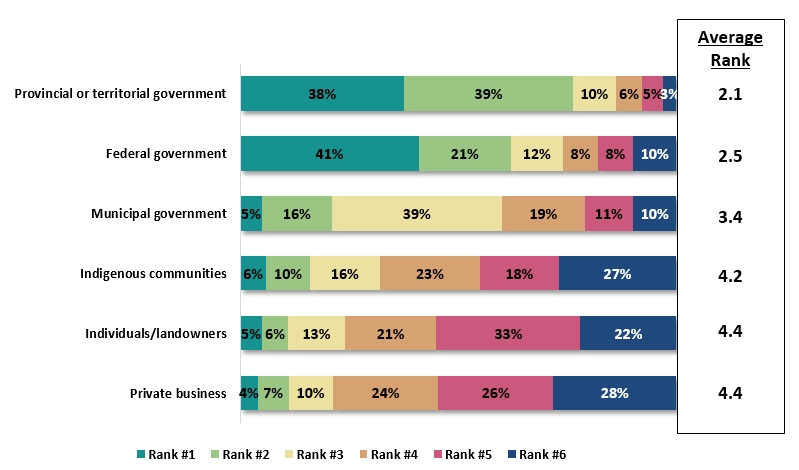
Nearly 2 in 5 respondents (38%) ranked the provincial or territorial government as having the primary responsibility for the recovery and protection of species primarily found within one province or territory.
The next most important stakeholder would be the federal government, who were considered the primary choice by 41% of respondents, and 21% ranking them second. In terms of average ranking, municipal governments ranked third and Indigenous communities ranked fourth. Individuals/landowners and private business were ranked last and next to last by a majority of respondents (22% and 28% respectively).
Key Segments
Provincial/Territorial Government
Respondents more likely to rank the provincial or territorial government as the top primary stakeholder to recover and protect a species in a province or territory compared to their counterparts include:
Federal Government
Respondents more likely to rank the federal government as the top primary stakeholder to recover and protect a species in a province or territory compared to their counterparts include:
Municipal Government
Indigenous Communities (in the Province or Territory)
Respondents more likely to rank indigenous communities as the top primary stakeholder to recover and protect a species in a province or territory compared to their counterparts include:
Individuals/Landowners (in the Province or Territory)
Private Businesses (in the Province or Territory)
Respondents more likely to rank private businesses as the top primary stakeholder to recover and protect a species in a province or territory compared to their counterparts include:
Respondents were asked to provide their level of agreement with statements regarding the prioritized protection of land slated for commercial development should either an animal species or plant species at risk of extinction be found.
Figure Y – Support for Prioritizing Protection of Species Over Commercial Development
Q26. To what extent do you agree or disagree with the following: Base: All respondents, n=2006.
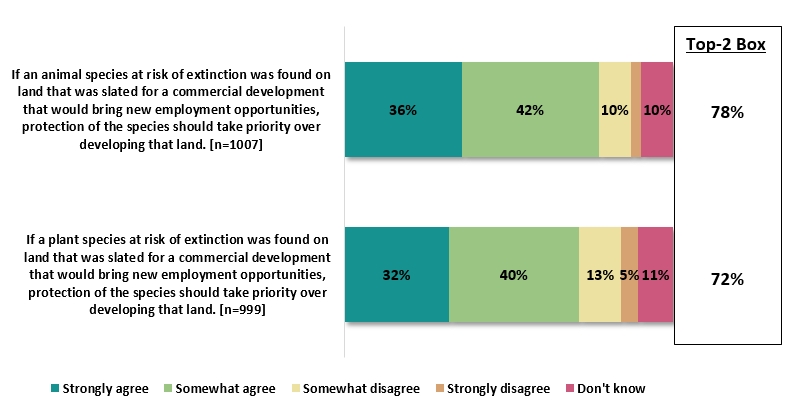
Nearly 4 in 5 respondents (78%) strongly or somewhat agreed that if an animal species at risk was found on land slated for commercial development bringing new employment opportunities, protection of the animal species should take priority over developing that land.
Nearly 3 in 4 respondents (72%) strongly or somewhat agreed that if a plant species at risk was found on land slated for commercial development, protection of the plant species should take priority over developing that land.
Key Segments
Respondents who specified the importance of nature to their personal well-being as very important were more likely to strongly or somewhat agree with both proposed approaches compared to those viewing nature’s importance to their well-being as somewhat or less important (83% vs 71% for animals and 79% vs 61% for plants).
Respondents between the ages of 18 and 34 years old were more likely to strongly or somewhat agree with both approaches compared to those 35 years of age or older (86% vs 75% for animals and 80% vs 69% for plants).
Indigenous respondents were more likely to strongly agree that protection of plant species should take priority compared to non-Indigenous respondents (45% vs 31%).
Respondents who strongly or somewhat agreed with the protection of either animal or plant species on land slated for commercial development were asked to select from a list of possible stakeholders who they felt should be responsible for protecting these species.
Figure Z – Responsibility for Protecting Species on Land Slated for Commercial Development
Q27. Who should be responsible for protecting that species living on land that is slated for a commercial development? Base: Respondents who very or somewhat agreed with prioritizing animal or plant species located on land slated for development, n=1497.
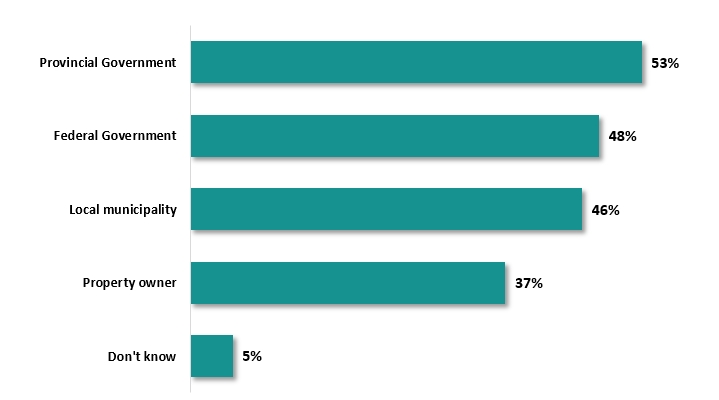
Among respondents already in favour of prioritizing the protection of an animal or plant species located on land slated for development, roughly half (53%) felt that the provincial government should be responsible for protecting the species. Slightly fewer felt the federal (48%) and the municipal governments should be responsible. Just over one-third (37%) also believed the landowner should be responsible. It is important to note that results do not add to 100% since respondents could choose more than one stakeholder. The results clearly show that respondents believe more than one stakeholder should be responsible.
Key Segments
Respondents more likely to rank the federal government as the top primary stakeholder to protect species living on land slated for commercial development compared to their counterparts include:
Respondents more likely to rank the provincial government as the top primary stakeholder to protect species living on land slated for commercial development compared to their counterparts include:
Respondents with a university education were more likely to select the local municipality as the top primary stakeholder to protect species living on land slated for commercial development compared to high school educated respondents (50% vs 39%).
Respondents more likely to rank the property owner as the top primary stakeholder to protect species living on land slated for commercial development compared to their counterparts include:
Respondents were asked to rank four stakeholders in terms of who they feel should be primarily responsibility for ensuring the protection of endangered plant populations and their habitats if these are found on privately managed land.
Figure A1 – Ranking Responsibility for Endangered Plant Populations on Private Land
Q28. For populations of a plant that is listed as an endangered species and found on privately managed land, who should be primarily responsible for ensuring the protection of that species and its habitat? Rank the items in order of priority. Base: All respondents, n=2006.
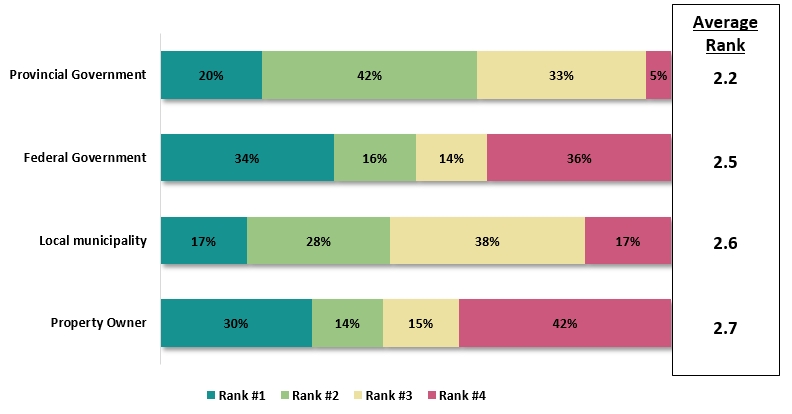
This question proved somewhat polarizing for respondents, especially in terms of considering the role of the federal government and property owners. For both of these stakeholders, a large number of respondents either felt they should be the most responsible party or they should be the least responsible party.
By focusing exclusively on the proportion of respondents who ranked each stakeholder in first position, results suggest that the federal government (34%) is seen as the most popular stakeholder to take primary responsibility in the described scenario, followed by property owners (30%). However, by considering the average rankings, we see that the provincial government receives the highest average ranking (2.2) with the other three stakeholders ranking fairly similarly.
Key Segments
Provincial Government
No specific groups ranked the Provincial Government as the most responsible stakeholder when compared to others.
Federal Government
Respondents more likely to rank the Federal Government as the most responsible stakeholder to ensure the protection of plant endangered species found on privately managed land, compared to their counterparts include:
Local Municipality
Respondents more likely to rank the local municipality as the most responsible stakeholder to ensure the protection of plant endangered species found on privately managed land, compared to their counterparts include:
Property Owner
Respondents more likely to rank the property owner as the most responsible stakeholder to ensure the protection of plant endangered species found on privately managed land, compared to their counterparts include:
Respondents were asked to state their level of agreement with statements regarding increased responsibility with and regulatory action among stakeholders to protect species at risk in Canada.
Figure B1 – Support for Specific Measures to Protect Species at Risk
Q29. To what extent do you agree or disagree with the following statements: Base: All respondents, n=2006.
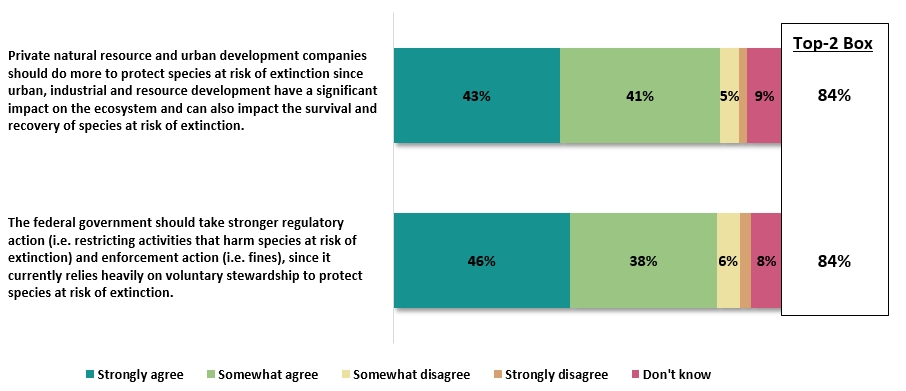
Results show that there is strong overall support for both proposed measures. They also show that results are very similar for both measures proposed. More specifically, 84% of respondents either strongly agree or somewhat agree that private natural resource and urban development companies should do more to protect species at risk of extinction. Similarly, 84% agree that the federal government should take stronger regulatory action and enforcement action, since it currently relies heavily on voluntary stewardship to protect species at risk of extinction. For both measures, over 40% strongly agree with the measure (43% and 46% respectively).
Key Segments
Respondents at least 55 years old were more likely to strongly or somewhat agree that private companies should be doing more to protect species when compared to those 54 years or younger (89% vs 82%).
Respondents with an education level greater than high school were more likely to strongly or somewhat agree with both measures when compared to those with a high school education (87% vs 81% when it comes to an increased role for the private sector).
Respondents who specified the importance of nature to their personal well-being as very important were more likely to strongly or somewhat agree with both measures when compared to those viewing nature’s importance to their well-being as somewhat or less important (90% vs 78% when it comes to an increased role for the private sector, and 89% vs 77% when it comes to an increased role for the federal government).
Report findings are based on a non-probability sample, as respondents had volunteered to participate in online surveys using an online panel. The data have been weighted to reflect the demographic composition of the Canadian general population. As the sample is based on those who initially self-selected for participation in the online panel, no estimates of sampling error can be calculated. All research work was conducted in accordance with the professional standards established by the Government of Canada Public Opinion Research Standards, as follows:
This report compares significant findings among key demographic subgroups including region, age gender, and importance of nature to individuals.
All research was conducted in accordance with the Standards for the Conduct of Government of Canada Public Opinion Research – Online Surveys.
| Segments | Total (n=2,006) Unweighted |
Total (n=2,006) Weighted |
|---|---|---|
| Region | ||
| British Columbia | 15% | 14% |
| Alberta | 13% | 11% |
| Saskatchewan | 5% | 3% |
| Manitoba | 7% | 4% |
| Ontario | 25% | 38% |
| Quebec | 23% | 23% |
| New Brunswick | 4% | 2% |
| Nova Scotia | 5% | 3% |
| Prince Edward Island | 1% | <1% |
| Newfoundland | 2% | 2% |
| Northwest Territories | 0% | 0% |
| Yukon | 0% | 0% |
| Nunavut | 0% | 0% |
| Age | ||
| Between 18 and 24 | 11% | 10% |
| Between 25 and 34 | 12% | 18% |
| Between 35 and 44 | 18% | 16% |
| Between 45 and 54 | 20% | 18% |
| Between 55 and 64 | 18% | 17% |
| Between 65 and 74 | 17% | 16% |
| 75 and older | 5% | 5% |
| Gender | ||
| Male | 50% | 49% |
| Female | 50% | 51% |
| Gender diverse | <1% | <1% |
| Prefer not to say | <1% | <1% |
| Children at Home | ||
| Children age 12 or younger | 18% | 18% |
| Children 13 to 17 years old | 12% | 12% |
| No children under 18 | 73% | 73% |
| Prefer not to answer | 2% | 2% |
| Language | ||
| English | 79% | 78% |
| French | 21% | 22% |
| Income | ||
| Under $20,000 | 6% | 7% |
| $20,000 to $39,999 | 15% | 14% |
| $40,000 to $59,999 | 14% | 14% |
| $60,000 to $79,999 | 16% | 16% |
| $80,000 to $99,999 | 14% | 14% |
| $100,000 to $149,999 | 17% | 16% |
| $150,000 or more | 9% | 10% |
| Prefer not to answer | 10% | 10% |
| Education | ||
| Grade 8 or less | <1% | <1% |
| Some high school | 3% | 3% |
| High school diploma or equivalent | 20% | 19% |
| Registered Apprenticeship or other trades certificates or diploma | 6% | 5% |
| College, CEGEP or other non-university certificate or diploma | 24% | 23% |
| University certificate or diploma below bachelor’s level | 8% | 8% |
| Bachelor’s degree | 25% | 27% |
| Postgraduate degree above bachelor’s level | 13% | 14% |
| Prefer not to answer | 1% | 1% |
| Population | ||
| A city or metropolitan area with a population of at least 100,000 | 56% | 58% |
| A city with a population of 30,000 to 100,000 | 16% | 17% |
| A city or town with a population of 10,000 to 30,000 | 9% | 9% |
| A town or rural area with a population under 10,000 | 18% | 16% |
| Prefer not to answer | 1% | 1% |
| Indigenous Groups | ||
| First Nations, which includes Status and Non–Status | 3% | 3% |
| Métis | 3% | 3% |
| Inuk or Inuit | <1% | 1% |
| None | 95% | 95% |
| Prefer not to answer | 2% | 2% |
Thank you for participating in this survey. Quorus Consulting Group, a Canadian market research firm, is conducting this survey on behalf of the Government of Canada. The survey will ask you questions regarding various issues and challenges facing Canada these days and your feedback is very important. The survey should take you about 9 minutes to complete. The survey is not a test of your knowledge, we simply seek your candid opinions.
Your participation is voluntary and completely confidential. All your answers will remain anonymous. The information provided will be managed according to the requirements of the Privacy Act. The final report on the survey will be available through Library and Archives Canada.
Vous pouvez également répondre au sondage en français.
PROV. Which province or territory do you live in?
Newfoundland and Labrador 1
Nova Scotia 2
Prince Edward Island 3
New Brunswick 4
Quebec 5
Ontario 6
Manitoba 7
Saskatchewan 8
Alberta 9
British Columbia 10
Yukon 11
Nunavut 12
Northwest Territories 13
Don’t know/Prefer not to answer 99
AGE. Please indicate in which of the following age categories you belong?
18 - 24 1
25 - 34 2
35 - 44 3
45 - 54 4
55 - 64 5
65 - 74 6
75 or older 7
Prefer not to answer 9
GENDER. What is your gender?
Male gender 1
Female gender 2
Gender diverse 3
Prefer not to answer 9
1. To start, how important is nature to your personal well-being?
Very important 1
Somewhat important 2
Not very important 3
Not at all important 4
Don’t know 9
2. How familiar are you with the following concepts and terms?
| [Randomize] | Very familiar | Somewhat familiar | Not very familiar | Not at all familiar | Don’t know |
|---|---|---|---|---|---|
| a) Climate change | |||||
| b) Species at risk of extinction | |||||
| c) Greenhouse gas emissions | |||||
| d) International environmental agreements | |||||
| e) Nature conservation | |||||
| f) Nature restoration | |||||
| g) Biodiversity | |||||
| h) Climate change adaptation | |||||
| i) Climate change mitigation | |||||
| j) Nature-based climate solutions, or Nature-Based Solutions |
3. Please state your level of awareness regarding the following Government of Canada environmental initiatives?
| [Randomize] | Very aware | Somewhat aware | Not very aware | Not at all familiar | Don’t know |
|---|---|---|---|---|---|
| a) Plant 2 billion trees by 2030 | |||||
| b) Restore wetlands, grasslands and other important ecosystems | |||||
| c) Protect 25% of Canada's lands and 25% of its oceans by 2025. | |||||
| d) Banning certain types of single use plastics by 2021 | |||||
| e) Achieving Net-Zero emissions by 2050 | |||||
| f) Reducing Canada’s green house gas emissions by 30% by 2030 | |||||
| g) Ensure Pollution Pricing/carbon tax (split sample) or Cap and trade systems exist in all provinces and territories within Canada | |||||
| h) Introduction of the clean fuel standard |
4. In case you had never heard of the term before, “Nature-Based Solutions” are defined as actions to protect, sustainably manage and restore natural or modified ecosystems, to address society’s challenges such as climate change, with multiple benefits for human well-being and biodiversity. Based on this definition, how realistic do you think the following statements are?
| [Randomize] | This is very realistic | This is somewhat realistic | This is not very realistic | This is not at all realistic | Don’t know |
|---|---|---|---|---|---|
| a) Trees capture carbon from the air and store it in their wood and in the ground. This reduces the amount of carbon in the air. | |||||
| b) When farmers use cover crops to prevent erosion between their main crops, they help to build carbon in the soil and keep it in the ground. | |||||
| c) The amount of carbon that can be captured and stored by trees and plants is large enough to help reduce Canada’s greenhouse gas pollution. |
5. Based on what you may have seen or heard, to what extent do you agree or disagree with the following statements?
| [Randomize] | Strongly agree | Somewhat agree | Somewhat disagree | Strongly disagree | Don’t know |
|---|---|---|---|---|---|
| a) Nature-based solutions help to reduce impacts from extreme weather events, such as flooding. | |||||
| b) Nature-based solutions focus on protecting, restoring, and sustainably managing nature to help solve challenges to society. |
6. How would you explain the concept of nature conservation to a friend or neighbour? We are not looking for a textbook explanation – we are interested in understanding how you would explain it in your own words.
[Open Text Box Field]
Don’t know/Prefer not to answer 99
7. To what extent do you agree or disagree with the following statements?
Conservation means…
| [Randomize] | Strongly agree | Somewhat agree | Somewhat disagree | Strongly disagree | Don’t know |
|---|---|---|---|---|---|
| …protecting nature exactly as it is, not allowing people to change it. | |||||
| …allowing human activity that is low-impact, and managing it so that nature is not degraded or destroyed. | |||||
| …activities that help nature to recover from damage caused by human activity or natural disturbances. |
8. In Canada, many natural wetlands have been drained and had their surrounding natural vegetation cleared away, so that the space could be used for other purposes. How familiar are you with the following benefits to nature when wetlands are restored, and their natural functions are revitalized?
| [Randomize] | Very familiar with this benefit | Somewhat familiar | Not very familiar | Not at all familiar with this benefit | Don’t know |
|---|---|---|---|---|---|
| a) Restored wetlands can capture and store carbon from the atmosphere. | |||||
| b) Restored wetlands can reduce the risk and extent of flooding by soaking up excess water from heavy rains and snowmelt. | |||||
| c) Restored wetlands can create food and habitat for birds, pollinators, and other animals. | |||||
| d) Restored wetlands can provide recreational and educational opportunities for people. |
9. Based on what you may have seen or heard, to what extent could the following actions be cost-effective to fight climate change?
| [Randomize] | Very cost-effective | Somewhat cost-effective | Not very cost-effective | Not cost-effective at all | Don’t know |
|---|---|---|---|---|---|
| a) Restoring and enhancing wetlands near farms and towns instead of building stormwater barriers made out of concrete. | |||||
| b) Investing in the protection of carbon-rich ecosystems like natural grasslands to reduce greenhouse gasses. | |||||
| c) Planting and keeping a lot of mature trees in cities to clean the air. |
10. Since 2017, Canada has recognized additional land and freshwater protected and conserved areas equivalent in size to three times the size of Nova Scotia, and now protects 12.1% of our land and inland waters. In the September 2020 Speech from the Throne, the federal government re-iterated its commitment to protect and conserve 25% by 2025. This commitment would include the creation of new parks, wildlife conservation areas and other types of protected areas. To what extent do you support this commitment?
Strongly support
Support
Oppose
Strongly oppose
Don’t have clear views either way
11. Provinces and territories control over 80% of Canada’s land and inland waters. To what extent do you agree or disagree the federal government should provide funding to provinces and territories to help with the creation of new parks and protected areas in order to advance the 25% target?
Strongly agree 1
Somewhat agree 2
Somewhat disagree 3
Strongly disagree 4
Don’t know 9
12. To what extent do you agree or disagree with the following statements:
| [RANDOMIZE] | Strongly agree | Somewhat agree | Somewhat disagree | Strongly disagree | Don’t know |
|---|---|---|---|---|---|
| a) The federal government should enable greater involvement of Indigenous peoples in protecting nature. | |||||
| b) The federal government should require improved land management practices so that “working landscapes” that contribute to conserving biodiversity (i.e. some forests, ranches, farms) can count towards the protected and conserved areas target while maintaining their contribution to the Canadian economy. | |||||
| c) The federal government should work with and provide funding to municipal governments to create more urban and municipal parks and green spaces to support biodiversity conservation at the local level. |
13. To what extent do you agree or disagree with the following approaches as ways to ensure that Canada can continue to have the funding needed to manage and grow protected and conserved areas:
| [RANDOMIZE STATEMENTS] | Strongly agree | Somewhat agree | Somewhat disagree | Strongly disagree | Don’t know |
|---|---|---|---|---|---|
| a) The federal government should ask foreign tourists entering Canada to pay a small border tax of $25 or less per visit to raise the public funds needed to expand nature conservation and protection in Canada, including the creation of new parks. | |||||
| b) There should be greater federal tax benefits for Canadians who donate land for nature conservation purposes, such as the Ecological Gifts Program. [Include bubble with definition of the EGP: The Ecological Gifts Program offers significant income tax benefits to landowners that donate gifts of ecologically sensitive land, or interests in the land, to eligible recipients. Since the start of the program in 1995, Canadians have donated more than 1,500 ecological gifts protecting over 100,000 ha of habitat for a total value of nearly $1 Billion.] | |||||
| c) The federal government should allow taxpayer money to be invested in new financing mechanisms, such as green bonds that allocate 100% of the proceeds to finance or pre-finance projects with specific environmental benefits such as parks and protected areas. |
14. Some governments require that companies undertaking projects like mines and pipelines compensate for environmental damage caused by their project. Compensation can be done by undertaking conservation projects, paying a company or a non-profit environmental organization to undertake a specific conservation project, or paying into a fund that supports conservation projects. To what extent do you agree or disagree that the federal government should develop a similar initiative that would require companies to compensate for the damage to the environment caused by their projects as a condition of their federal project approval?
Strongly agree 1
Somewhat agree 2
Somewhat disagree 3
Strongly disagree 4
Don’t know 9
15. [If “Strongly agree” or “Somewhat agree” to previous question] Which of the following approaches would you prefer the federal government use to make companies compensate for environmental damage caused by their projects? Select only one.
Companies undertake conservation projects themselves 1
Companies pay other companies to carry out conservation projects 2
Companies pay non-profit environmental organizations to carry out
conservation projects 3
Companies pay into a fund that supports conservation projects 4
16. Do you have any other views or examples on how Canada could accelerate progress on creating new protected and conserved areas?
[Open Text Box Field]
Don’t know/Prefer not to answer 99
17. Please indicate how much of a priority, if at all, each of the following environmental issues should be for the Government of Canada. (Please use a scale from 1 to 10, where 1 means very low priority and 10 means very high priority).
| [RANDOMIZE STATEMENTS] | 1 – Very low priority | 2 | 3 | 4 | 5 | 6 | 7 | 8 | 9 | 10 – Very high priority | Don’t know |
|---|---|---|---|---|---|---|---|---|---|---|---|
| a) Reducing greenhouse gas emissions / Fighting climate change [SPLIT SAMPLE] | |||||||||||
| b) Protecting Canada’s National Parks and National Wildlife Areas / Creating new National Parks and National Wildlife Areas [SPLIT SAMPLE] | |||||||||||
| c) Creating more urban parks and green spaces | |||||||||||
| d) Reducing water pollution | |||||||||||
| e) Reducing air pollution | |||||||||||
| f) Reducing garbage and waste | |||||||||||
| g) Protecting natural habitats for wildlife / Protecting endangered species / Protecting endangered plant species [SPLIT SAMPLE IN THREE] | |||||||||||
| h) Creating green jobs / Creating clean jobs [SPLIT SAMPLE] |
18. Let’s turn our attention to species at risk of extinction in Canada.
There are currently 622 terrestrial and aquatic species at risk of extinction in Canada, including caribou, right whale, greater sage grouse, red-legged frog, white sturgeon, salish sucker, western bumble bee and golden paintbrush. How important is it to you personally that species at risk of extinction across Canada are protected?
Very important 1
Somewhat important 2
Not very important 3
Not at all important 4
Don’t know 9
19. To what extent do you agree or disagree that the federal government should focus its species-specific conservation efforts and investments on a manageable number of ecologically important and wide-ranging priority species, such as caribou, greater sage-grouse, and wood bison?
Strongly agree 1
Somewhat agree 2
Somewhat disagree 3
Strongly disagree 4
Don’t know 9
20. Which of the following statements does your opinion best align with:
“Given the limited resources and funding to advance protecting species at risk of extinction in Canada, the federal government should set priorities and focus efforts and investments on…
[SELECT ONLY ONE]
…a select set of species and ecosystems
…spread resources across all species at risk of extinction
…balance of both approaches
Other, please specify: _______________
None of the above [EXCLUSIVE]
21. If you were faced with the challenge of prioritizing resources in Canada to protect some species instead of others, what criteria would you use? We propose a list of criteria below – rank them in terms of how important you believe that criteria would be, in other words those at the top of your list would be prioritized species. Rank the items in order of priority.
22. Would you prioritize certain species using any other criteria besides the ones we’ve proposed? If so, what would that criteria be?
[Open Text Box Field]
No other criteria comes to mind 98
Don’t know/Prefer not to answer 99
23. Species conservation includes government making difficult decisions. To what extent do you agree or disagree with an approach that would abandon recovery efforts for some species, in favour of focusing on other species that have a higher chance of survival?
Strongly agree 1
Somewhat agree 2
Somewhat disagree 3
Strongly disagree 4
Don’t know 9
24. Who should take primary responsibility for the recovery and protection of species at risk of extinction in Canada? Rank the items below in order of priority.
25. Whom do you think should take primary responsibility to recover and protect a species, if it is found primarily within one province or territory? Rank the items in order of priority.
26. To what extent do you agree or disagree with the following:
If [SPLIT SAMPLE] an animal species/a plant species at risk of extinction was found on land that was slated for a commercial development that would bring new employment opportunities, protection of the species should take priority over developing that land.
Strongly agree 1
Somewhat agree 2
Somewhat disagree 3
Strongly disagree 4
Don’t know 9
27. [Ask if “strongly agree” or “somewhat agree” in previous question]
Who should be responsible for protecting that species living on land that is slated for a commercial development? Select all that apply.
Property owner 1
Local municipality 2
Provincial Government 3
Federal Government 4
Don’t know [Exclusive] 9
28. For populations of a plant that is listed as an endangered species and found on privately managed land, who should be primarily responsible for ensuring the protection of that species and its habitat? Rank the items in order of priority? Rank the items in order of priority.
29. To what extent do you agree or disagree with the following statements:
| [RANDOMIZE STATEMENTS] | Strongly agree | Somewhat agree | Somewhat disagree | Strongly disagree | Don’t know |
|---|---|---|---|---|---|
| a) Private natural resource and urban development companies should do more to protect species at risk of extinction since urban, industrial and resource development have a significant impact on the ecosystem and can also impact the survival and recovery of species at risk of extinction. | |||||
| b) The federal government should take stronger regulatory action (i.e. restricting activities that harm species at risk of extinction) and enforcement action (i.e. fines), since it currently relies heavily on voluntary stewardship to protect species at risk of extinction. |
The last few questions are strictly for statistical purposes. All of your answers are completely confidential.
30. Do you currently live in…
A city or metropolitan area with a population of at least 100,000 1
A city with a population of 30,000 to 100,000 2
A city or town with a population of 10,000 to 30,000 3
A town or rural area with a population under 10,000 4
Prefer not to answer 9
31. Please indicate whether you belong to any of the following indigenous groups:
| Yes | 1 |
| No | 2 |
| Prefer not to answer | 9 |
32. What is the highest level of formal education that you have completed? Select one only.
Grade 8 or less 1
Some high school 2
High school diploma or equivalent 3
Registered Apprenticeship or other trades certificate or diploma 4
College, CEGEP or other non-university certificate or diploma 5
University certificate or diploma below bachelor's level 6
Bachelor's degree 7
Postgraduate degree above bachelor's level 8
Prefer not to answer 9
33. Please specify the number of children living at home with you in the following age categories:
# of children age 12 or younger ______
# of children 13 to 17 years old ______
I do not have children under 18 living with me 88
Prefer not to answer 99
34. Which of the following categories best describes your total household income in 2019? That is, the total of all persons in your household combined, before taxes.
Under $20,000 1
$20,000 to $39,999 2
$40,000 to $59,999 3
$60,000 to $79,999 4
$80,000 to $99,999 5
$100,000 to $149,999 6
$150,000 or more 7
Prefer not to answer 9
PRETEST QUESTIONS [TO BE REMOVED AFTER COMPLETING PRETEST]:
The survey you just finished is one of the very first we have done for this project, please answer the following few questions to help us improve the survey.
P1. Overall, how would you rate the extent to which the questions in this survey were easy to understand? Please use a scale from 0 to 10 where 0 means “very difficult”, and 10 means “very easy”.
| Very difficult |
Very Easy |
|||||||||
| 0 | 1 | 2 | 3 | 4 | 5 | 6 | 7 | 8 | 9 | 10 |
P2. [IF P1 IS LESS THAN 8] Please tell us why you gave this rating to the survey. What specific questions or words did you find difficult to understand?
P3. Approximately, how long did it take you to complete the survey?
______ minutes
This concludes the survey. Your answers have been submitted. Thank you for your participation!